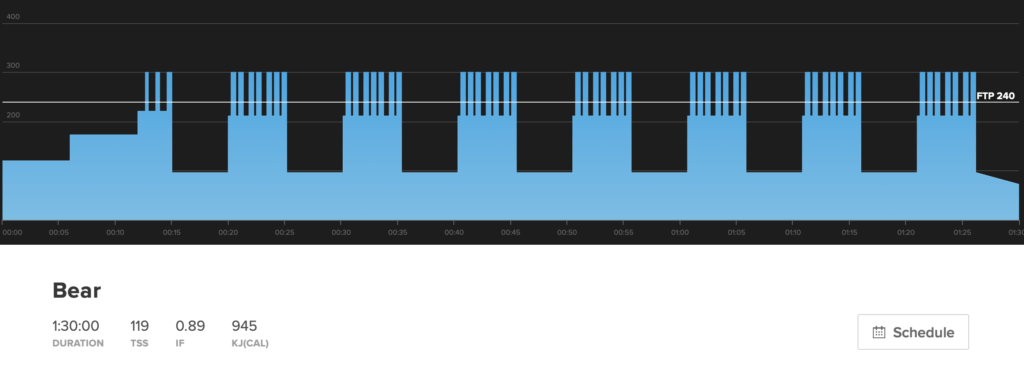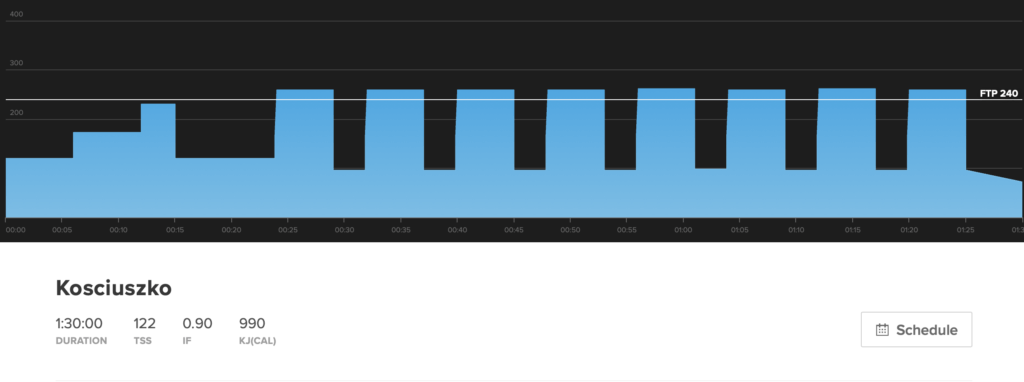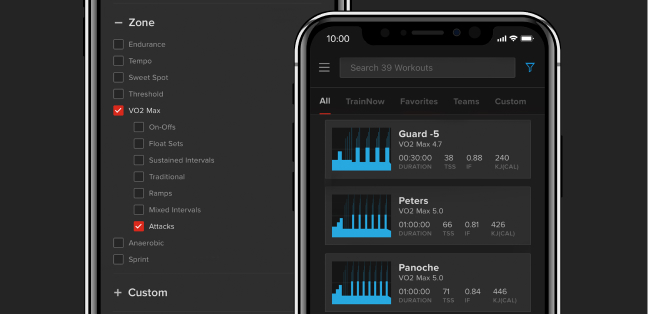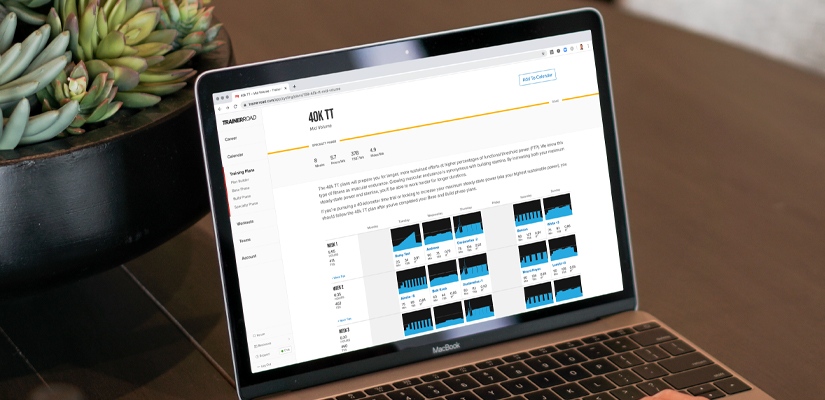Interval Training for Cyclists: Interval Types & How to Use Them

Interval training is the best way to become a faster cyclist. By selectively training specific energy systems, you can make the most of your training time. With so many types of intervals, choosing what to do can be a bit overwhelming. In this article, we’ll cover the intricacies of cycling interval training.
What are Intervals?
The most straightforward description of intervals is alternating high-power bursts with periods of rest. Typically the high-power segment is targeted to a specific power zone. There are intervals designed to raise your threshold, VO2 Max, and sprint power. A typical interval workout will feature several intervals called a set. At the end of each set, there will be a period of extended recovery before the next one begins.
Let’s take a look at the workout Baird. This is a VO2 Max interval workout where you complete three sets of five, one-minute VO2 Max intervals with a minute of rest in between. At the end of the set, you’ll have eight minutes of recovery before beginning the next set of intervals.

Depending on the targeted energy system, the intervals may be shorter or longer, but all are scaled to your fitness level—FTP. Usually, the most intense intervals are shorter and lengthen as you lower the intensity. For example, a sprint interval may only be 15 seconds, but a sweet spot one could be twenty minutes.
How Does Interval Training Make You Faster?
Interval training is the best way to sharpen the specific energy systems that you’ll need for your event. But what makes them so effective?
Interval structure allows you to complete more work in a power zone than you would otherwise. Athletes get faster by targeting specific energy systems through a distinct balance of work and recovery in every workout. For instance, a cyclist wouldn’t be able to hold VO2 Max power for 10 minutes straight. But with an interval workout, you can do more work. In Baird, you’d spend 15 minutes in the VO2 Max zone. In other words, intervals allow you to do more high-quality work—and that makes you faster.
Types of Cycling Intervals
These are just a few of the more traditional and popular intervals used in cycling training. Really, it’s just scratching the surface. There are almost infinite ways that each interval workout can be modified and combined as well.
- VO2 Max
These target your maximal oxygen uptake and are spent at 106%-120% of FTP. They last anywhere between 1-5 minutes long. - Billats
Sometimes called 30-30s, Billats are VO2 Max intervals of 30 seconds of work followed by 30 seconds of rest. They are typically done 3 sets of 10 with a full recovery in between sets. - Tabata
Tabata intervals are anaerobic focused intervals with 20 seconds of max power followed by 10 seconds of rest. Repeat 8 times to complete a set. The original Tabata workout is only one set. - Over-Unders
This is threshold-specific work that trains your body to deal with metabolic byproducts that come with riding above FTP. These vary in length, but typically a 12 minute over/under interval will alternate 2 minutes at 95% of FTP and 2 minutes at 105% of FTP 3 times. - Sweet Spot
These intervals are all about building your aerobic base and muscular endurance. They are hard enough to drive adaptation but don’t require the recovery demanded from higher-intensity work. They can last anywhere from 8 minutes to 30 minutes spent between 88%-94% of FTP.
TrainerRoad’s Cycling Intervals
It can be troublesome with so many different interval types and possible combinations to find the right type of workout you want. TrainerRoad makes that process easier by organizing interval workouts by training zone and duration. You can even filter workouts by particular types of intervals.
Workout Profiles
Every TrainerRoad workout is categorized not on by training zone but also by workout profiles. Workout profiles are the way TrainerRoad gives a more refined level of detail for interval structure and type. Why is this important? Varying interval structures can profoundly affect how a workout feels, and most importantly, how intervals build specific fitness.
Let’s look at two different VO2 Max interval workouts. Bear contains seven float sets that last five minutes each. These intervals have you riding for 25 seconds at 125% FTP and the float at 88% FTP. This kind of workout develops your ability to quickly generate aerobic power and muscular recruitment—both in terms of how hard and how quickly you can muster that strength.

On the other hand, Kosciusko features longer five-minute intervals at 108% FTP. While at the lower end of VO2 Max work, this workout is all about increasing your sustainable power and muscular endurance while increasing your ability to process metabolic byproducts.

Both Bear and Kosciusko are VO2 Max workouts, but with different interval structures and different outcomes. You can easily find the exact interval type and training zone you want in the workout filters. Just select the training zone, then a workout profile to find a the workout you want.
How Long Should Intervals Be?
The length of intervals is dependant on several factors. The first factor is the energy system that you are training. Typically, the higher the power, the shorter the time. For example, a sprint interval will be less than 30 seconds, but a sweet spot interval could be 20 minutes or longer. But generally, sprint intervals are less the 30 seconds and VO2 Max is between 1-5 minutes long. Threshold and sweet spot intervals can vary from about 8 minutes to 40 minutes.
Adaptive Training
Get the right workout, every time with training that adapts to you.
Check Out TrainerRoadAdditionally, your experience will factor into how long the interval should be. If you are just starting with a training plan or have a new FTP, the intervals should be shorter (but more repeats), then progressively lengthen from week to week. However, there are limits to how long an interval should be. The goal is to maximize the quality of the work you are doing over the entire workout.
So while you may be able to do one 5-minute VO2 Max interval, you might not be able to repeat that several times. Instead, starting with 90 seconds of work, you can hit your targets and get enough time in that zone to drive adaptations.
How Often Should I do Interval Training?
Since interval training is so effective, should you do them every day? The simple answer is no. The longer answer is that there are diminishing returns completing threshold or above intervals more than three times a week. Too much intensity will overwhelm your ability to recover, thereby compromising the quality of the next workout.
A better method is to space out interval workouts throughout the week. The days in between can be filled with endurance rides, or if you don’t have the time—rest.
Intervals Specific for Your Discipline
As a part of a structured training plan, interval training should progressively target the type of event for which you are preparing. Your training phase will determine the types of intervals you complete.
During the Base Phase, you can get faster with intervals by maximizing your available training time. With a combination of Sweet Spot and VO2 Max workouts, you can build your aerobic base, which serves as the foundation for your fitness peak.
As you progress into the Build Phase, the intervals will become more specific to your event. If you are planning on racing a criterium, your workouts will lean towards very high, but short power bursts. However, if you are targeting a time trial, the intervals will be more focused on your sustained power in the threshold zone.
During the Speciality Phase, intervals become even more race-specific. As your event nears, your workouts’ intensity will sharpen fitness, while your overall training volume will lessen to help shed fatigue. That way, you’ll hit peak fitness just in time.
Interval training can seem overwhelming due to the myriad of options available. TrainerRoad takes care of the details and gives you structured training without the complications. You can use Plan Builder to create a customized training plan automatically built for your goals. That way, you can focus on the work and get faster as a result.
For more cycling training knowledge, listen to Ask a Cycling Coach — the only podcast dedicated to making you a faster cyclist. New episodes are released weekly.
References and Further Reading
- Gastin PB., (2001). Energy system interaction and relative contribution during maximal exercise. https://www.ncbi.nlm.nih.gov/pubmed/11547894
- Tabata, Izumi; Nishimura, Kouji; Kouzaki, Motoki; Et. Al. Effects of moderate-intensity endurance and high-intensity intermittent training on anaerobic capacity and ˙VO2max, Medicine & Science in Sports & Exercise: October 1996 – Volume 28 – Issue 10 – p 1327-1330 https://journals.lww.com/acsm-msse/Fulltext/1996/10000/Effects_of_moderate_intensity_endurance_and.18.aspx
- Ross, A., Leveritt, M., (2001) Long-term metabolic and skeletal muscle adaptations to short-sprint training: implications for sprint training and tapering. https://www.ncbi.nlm.nih.gov/pubmed/11735686
- Billat, VL., Slawinski, J., Bocquet, V., Demarle, A., Lafitte, L., Chassaing, P., Koralsztein, JP., (2000) Intermittent runs at the velocity associated with maximal oxygen uptake enables subjects to remain at maximal oxygen uptake for longer time than intense but submaximal runs. https://www.ncbi.nlm.nih.gov/pubmed/10638376
- Jeukendrup, A.E., Martin, J. Improving Cycling Performance. Sports Med 31, 559–569 (2001). https://doi.org/10.2165/00007256-200131070-00009

